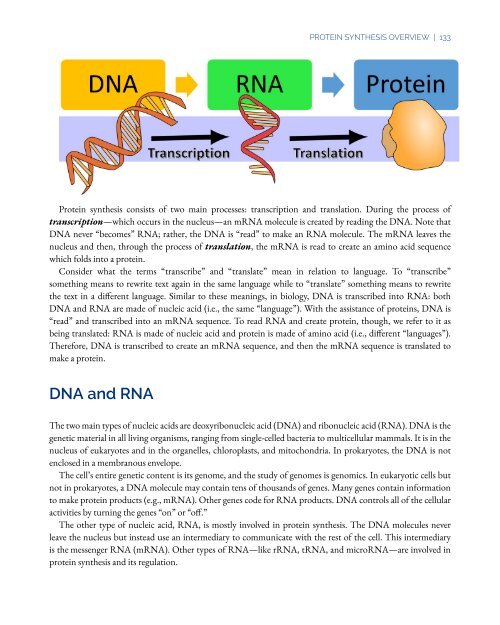An Interactive Introduction to Organismal and Molecular Biology, 2021
An Interactive Introduction to Organismal and Molecular Biology, 2021
An Interactive Introduction to Organismal and Molecular Biology, 2021
Create successful ePaper yourself
Turn your PDF publications into a flip-book with our unique Google optimized e-Paper software.
PROTEIN SYNTHESIS OVERVIEW | 133<br />
Protein synthesis consists of two main processes: transcription <strong>and</strong> translation. During the process of<br />
transcription—which occurs in the nucleus—an mRNA molecule is created by reading the DNA. Note that<br />
DNA never “becomes” RNA; rather, the DNA is “read” <strong>to</strong> make an RNA molecule. The mRNA leaves the<br />
nucleus <strong>and</strong> then, through the process of translation, the mRNA is read <strong>to</strong> create an amino acid sequence<br />
which folds in<strong>to</strong> a protein.<br />
Consider what the terms “transcribe” <strong>and</strong> “translate” mean in relation <strong>to</strong> language. To “transcribe”<br />
something means <strong>to</strong> rewrite text again in the same language while <strong>to</strong> “translate” something means <strong>to</strong> rewrite<br />
the text in a different language. Similar <strong>to</strong> these meanings, in biology, DNA is transcribed in<strong>to</strong> RNA: both<br />
DNA <strong>and</strong> RNA are made of nucleic acid (i.e., the same “language”). With the assistance of proteins, DNA is<br />
“read” <strong>and</strong> transcribed in<strong>to</strong> an mRNA sequence. To read RNA <strong>and</strong> create protein, though, we refer <strong>to</strong> it as<br />
being translated: RNA is made of nucleic acid <strong>and</strong> protein is made of amino acid (i.e., different “languages”).<br />
Therefore, DNA is transcribed <strong>to</strong> create an mRNA sequence, <strong>and</strong> then the mRNA sequence is translated <strong>to</strong><br />
make a protein.<br />
DNA <strong>and</strong> RNA<br />
The two main types of nucleic acids are deoxyribonucleic acid (DNA) <strong>and</strong> ribonucleic acid (RNA). DNA is the<br />
genetic material in all living organisms, ranging from single-celled bacteria <strong>to</strong> multicellular mammals. It is in the<br />
nucleus of eukaryotes <strong>and</strong> in the organelles, chloroplasts, <strong>and</strong> mi<strong>to</strong>chondria. In prokaryotes, the DNA is not<br />
enclosed in a membranous envelope.<br />
The cell’s entire genetic content is its genome, <strong>and</strong> the study of genomes is genomics. In eukaryotic cells but<br />
not in prokaryotes, a DNA molecule may contain tens of thous<strong>and</strong>s of genes. Many genes contain information<br />
<strong>to</strong> make protein products (e.g., mRNA). Other genes code for RNA products. DNA controls all of the cellular<br />
activities by turning the genes “on” or “off.”<br />
The other type of nucleic acid, RNA, is mostly involved in protein synthesis. The DNA molecules never<br />
leave the nucleus but instead use an intermediary <strong>to</strong> communicate with the rest of the cell. This intermediary<br />
is the messenger RNA (mRNA). Other types of RNA—like rRNA, tRNA, <strong>and</strong> microRNA—are involved in<br />
protein synthesis <strong>and</strong> its regulation.


















